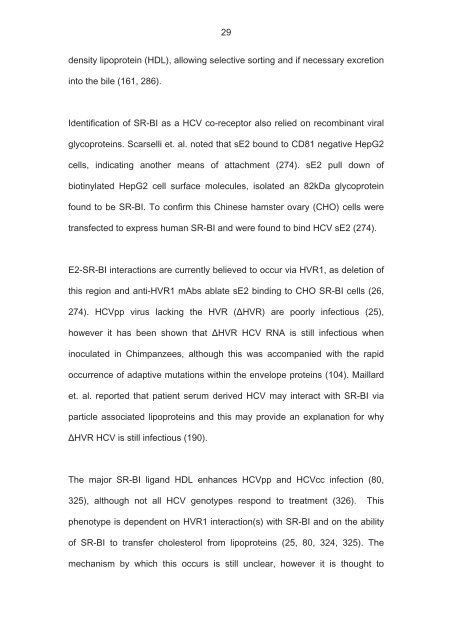The role of scavenger receptor BI in hepatitis - eTheses Repository ...
The role of scavenger receptor BI in hepatitis - eTheses Repository ...
The role of scavenger receptor BI in hepatitis - eTheses Repository ...
You also want an ePaper? Increase the reach of your titles
YUMPU automatically turns print PDFs into web optimized ePapers that Google loves.
29<br />
density lipoprote<strong>in</strong> (HDL), allow<strong>in</strong>g selective sort<strong>in</strong>g and if necessary excretion<br />
<strong>in</strong>to the bile (161, 286).<br />
Identification <strong>of</strong> SR-<strong>BI</strong> as a HCV co-<strong>receptor</strong> also relied on recomb<strong>in</strong>ant viral<br />
glycoprote<strong>in</strong>s. Scarselli et. al. noted that sE2 bound to CD81 negative HepG2<br />
cells, <strong>in</strong>dicat<strong>in</strong>g another means <strong>of</strong> attachment (274). sE2 pull down <strong>of</strong><br />
biot<strong>in</strong>ylated HepG2 cell surface molecules, isolated an 82kDa glycoprote<strong>in</strong><br />
found to be SR-<strong>BI</strong>. To confirm this Ch<strong>in</strong>ese hamster ovary (CHO) cells were<br />
transfected to express human SR-<strong>BI</strong> and were found to b<strong>in</strong>d HCV sE2 (274).<br />
E2-SR-<strong>BI</strong> <strong>in</strong>teractions are currently believed to occur via HVR1, as deletion <strong>of</strong><br />
this region and anti-HVR1 mAbs ablate sE2 b<strong>in</strong>d<strong>in</strong>g to CHO SR-<strong>BI</strong> cells (26,<br />
274). HCVpp virus lack<strong>in</strong>g the HVR ("HVR) are poorly <strong>in</strong>fectious (25),<br />
however it has been shown that "HVR HCV RNA is still <strong>in</strong>fectious when<br />
<strong>in</strong>oculated <strong>in</strong> Chimpanzees, although this was accompanied with the rapid<br />
occurrence <strong>of</strong> adaptive mutations with<strong>in</strong> the envelope prote<strong>in</strong>s (104). Maillard<br />
et. al. reported that patient serum derived HCV may <strong>in</strong>teract with SR-<strong>BI</strong> via<br />
particle associated lipoprote<strong>in</strong>s and this may provide an explanation for why<br />
"HVR HCV is still <strong>in</strong>fectious (190).<br />
<strong>The</strong> major SR-<strong>BI</strong> ligand HDL enhances HCVpp and HCVcc <strong>in</strong>fection (80,<br />
325), although not all HCV genotypes respond to treatment (326). This<br />
phenotype is dependent on HVR1 <strong>in</strong>teraction(s) with SR-<strong>BI</strong> and on the ability<br />
<strong>of</strong> SR-<strong>BI</strong> to transfer cholesterol from lipoprote<strong>in</strong>s (25, 80, 324, 325). <strong>The</strong><br />
mechanism by which this occurs is still unclear, however it is thought to

















